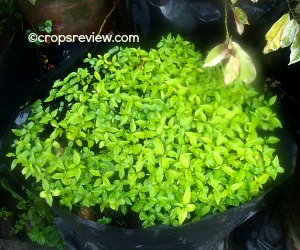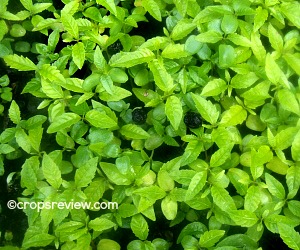Both sexual and asexual methods are applicable in propagating molave or tugas trees (Vitex parviflora Juss.).
Sexual methods consist of using extracted seeds and intact fruits, including wildlings that originate from the embryo within seeds.
Asexual methods include the use of stem cuttings.
This paper is about the propagation of molave using fruits and seeds.
The use of wildlings and stem cuttings as propagating materials is dealt with on another page (click here to read).
But first, the distinction between the fruit and seed of the molave tree.
A molave tree has many tiny flowers (~6-8 mm long), attached to the branches of a panicle (flower cluster like that in rice) having a peduncle (stalk) that emerges from the tip of a stem.
After pollination and double fertilization, each flower develops into a plant organ which is botanically called fruit (click to read What is a Fruit?).

The fruit is small (diameter about 5-6 mm), somewhat globe-shaped, colored green but turns blue-violet to black when ripe and dried.
Ripening of fruits on the same tree does not occur at the same time but gradually. Contrary to common usage, the fruit of molave is not edible.
Freshly detached ripe fruits, those which are easily visible on the ground under the tree canopy or those still attached to the panicle, are fleshy with soft outer enclosure (the pericarp or fruit wall, or pulp).
But they become hard and dry after a few days on the ground or after drying.
Inside each fruit is a seed (but some authorities say up to 3 or 4 seeds).
Even when an intact fruit is used as propagating material, it is the seed, particularly the embryo inside, which develops into a seedling.
Steps in Propagating Molave Using Seeds:
1. Collect ripe fruits from the tree or from the ground under the tree canopy.
2. Soak dried fruits in water and discard those that float.

3. Extract the seeds from the fruits by pressing between fingers.
4. Sow the seeds in individual pots or on a seedbed.
5. Prick the seedlings from the seedbed and transfer to individual pots.
6. Take care of the seedlings following usual nursery practices.
The steps in propagating molave using fruits (seeds surrounded with pulp or pericarp) are the same as in seed propagation with the exception that intact fruits are used instead of seeds.
Seed extraction is thus dispensed with.
Nevertheless, the resulting seedlings in fruit propagation originate from the same embryos in the seeds.
To ensure a high percentage of germination, the seed floatation method should be applied to dried fruits collected from the ground.
Put the fruits in a pail or basin containing water and discard those that will float.
How We Propagated Molave Trees Using Intact Fruits
On several occasions, we propagated molave trees from a few freshly harvested fruits.
We squeezed each fruit by the thumb and forefinger and the depulped seed is immediately pushed into potted medium.
The depth of sowing was just enough to conceal the seed under the surface of the potting medium.
But sometime in April this year, my sister brought home a few handfuls of fruits of the molave tree, tugas babae type.
The fruits were all colored black but mixed soft and hard, indicating that they were separated from the tree in different periods of time.
Believing that the seeds of molave are recalcitrant, we sowed the intact fruits immediately without drying.
Such a method of propagating molave is an application of direct seeding which, from experience, we found to be the general rule for recalcitrant seeds.
Recalcitrant seeds occur in the Bungalon or Grey mangrove (Avicennia marina) of the family Verbenaceae, the same family that the molave tree belongs to.
With rare exceptions, the existence of seed recalcitrance in any plant indicates that other plant species under the same family as the former likewise have the same seed characteristic (Fernandez 1993).
We simply spread the fruits on top of a pot of soil and covered the fruits partly with additional soil.
The pot was placed where direct sun exposure was about three hours per day starting at noontime and regularly watered.
Seedling emergence started about two weeks from sowing.
Propagating molave by intact fruits should be more advantageous because it eliminates the process of seed extraction.
LITERATURE CITED
FERNANDEZ, P.G. (ed.). 1993. Recalcitrant seeds and intermediates. Agroforestry Seeds Circular No, 3. (March 1993). pp. 22-26.
I Molave Botany and Growth I Tugas Lanhan vs. Tugas Babae I Uses and Prospects I Alternative Propagation I Molave Bonsai I
